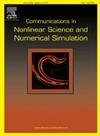人工智能驱动的混沌控制:一种基于变压器的动态系统方法
IF 3.8
2区 数学
Q1 MATHEMATICS, APPLIED
Communications in Nonlinear Science and Numerical Simulation
Pub Date : 2025-06-26
DOI:10.1016/j.cnsns.2025.109085
引用次数: 0
摘要
动力系统中的混沌行为对轨迹控制提出了重大挑战,传统上依赖于计算密集型的物理模型。我们提出了一种基于机器学习的算法来计算将粒子无限期地限制在一个区域内所需的最小控制边界,仅使用发散轨道的第一次迭代作为系统所需的信息。这种无模型方法具有较高的精度,均方误差为2.88×10−4,计算时间在秒级范围内。结果显示了该方法在混沌系统实时控制方面的有效性和潜力。本文章由计算机程序翻译,如有差异,请以英文原文为准。
AI-driven control of chaos: A transformer-based approach for dynamical systems
Chaotic behavior in dynamical systems poses a significant challenge in trajectory control, traditionally relying on computationally intensive physical models. We present a machine learning-based algorithm to compute the minimum control bounds required to confine particles within a region indefinitely, using only the first iterations of diverging orbits as required information of the system. This model-free approach achieves high accuracy, with a mean squared error of and computation times in the range of seconds. The results highlight its efficiency and potential for real-time control of chaotic systems.
求助全文
通过发布文献求助,成功后即可免费获取论文全文。
去求助
来源期刊

Communications in Nonlinear Science and Numerical Simulation
MATHEMATICS, APPLIED-MATHEMATICS, INTERDISCIPLINARY APPLICATIONS
CiteScore
6.80
自引率
7.70%
发文量
378
审稿时长
78 days
期刊介绍:
The journal publishes original research findings on experimental observation, mathematical modeling, theoretical analysis and numerical simulation, for more accurate description, better prediction or novel application, of nonlinear phenomena in science and engineering. It offers a venue for researchers to make rapid exchange of ideas and techniques in nonlinear science and complexity.
The submission of manuscripts with cross-disciplinary approaches in nonlinear science and complexity is particularly encouraged.
Topics of interest:
Nonlinear differential or delay equations, Lie group analysis and asymptotic methods, Discontinuous systems, Fractals, Fractional calculus and dynamics, Nonlinear effects in quantum mechanics, Nonlinear stochastic processes, Experimental nonlinear science, Time-series and signal analysis, Computational methods and simulations in nonlinear science and engineering, Control of dynamical systems, Synchronization, Lyapunov analysis, High-dimensional chaos and turbulence, Chaos in Hamiltonian systems, Integrable systems and solitons, Collective behavior in many-body systems, Biological physics and networks, Nonlinear mechanical systems, Complex systems and complexity.
No length limitation for contributions is set, but only concisely written manuscripts are published. Brief papers are published on the basis of Rapid Communications. Discussions of previously published papers are welcome.
 求助内容:
求助内容: 应助结果提醒方式:
应助结果提醒方式:


